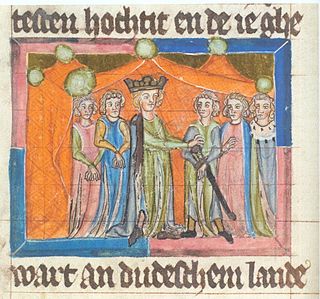
Year 1184 (MCLXXXIV) was a leap year starting on Sunday of the Julian calendar.

Minamoto no Yoritomo was the founder and the first shogun of the Kamakura shogunate, ruling from 1192 until 1199, also the first ruling shogun in the history of Japan. He was the husband of Hōjō Masako who acted as regent (shikken) after his death.

Minamoto no Yoshinaka, also known as Kiso Yoshinaka, was a Japanese samurai lord mentioned in the epic poem The Tale of the Heike. A member of the Minamoto clan, he was a cousin and rival of shogun Minamoto no Yoritomo during the Genpei War between the Minamoto and the Taira clans in the late Heian period.
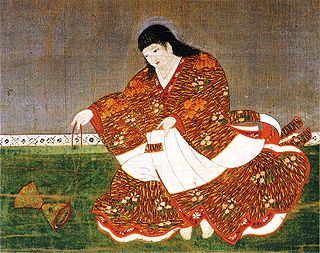
Emperor Antoku was the 81st emperor of Japan, according to the traditional order of succession. His reign spanned the years from 1180 through 1185. His death marked the end of the Heian period and the beginning of the Kamakura period.
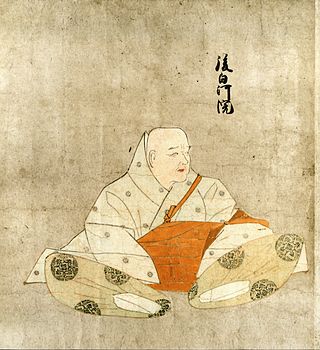
Emperor Go-Shirakawa was the 77th emperor of Japan, according to the traditional order of succession. His de jure reign spanned the years from 1155 through 1158, though arguably he effectively maintained imperial power for almost thirty-seven years through the insei system – scholars differ as to whether his rule can be truly considered part of the insei system, given that the Hōgen Rebellion undermined the imperial position. However, it is broadly acknowledged that by politically outmaneuvering his opponents, he attained greater influence and power than the diminished authority of the emperor's position during this period would otherwise allow.

The Genpei War was a national civil war between the Taira and Minamoto clans during the late Heian period of Japan. It resulted in the downfall of the Taira and the establishment of the Kamakura shogunate under Minamoto no Yoritomo, who appointed himself as Shōgun in 1192, governing Japan as a military dictator from the eastern city of Kamakura.

The Tale of the Heike is an epic account compiled prior to 1330 of the struggle between the Taira clan and Minamoto clan for control of Japan at the end of the 12th century in the Genpei War (1180–1185).
Hiuchiyama (火打ち山) was one of Minamoto no Yoshinaka's fortresses in Echizen Province, Japan. In April and May 1183, a Taira force led by Taira no Koremori attacked the fortress.

The battle of Kurikara Pass, also known as the battle of Tonamiyama (砺波山), was a crucial engagement in Japan's Genpei War; in this battle the tide of the war turned in the favour of the Minamoto clan.
The naval battle of Mizushima took place on 17 November 1183 during the Genpei War. One of the most important bases of the Taira was Yashima, a small island off the coast of Shikoku. In November 1183, Minamoto no Yoshinaka sent an army to cross the Inland Sea to Yashima, but they were caught by the Taira just offshore of Mizushima (水島), a small island of Bitchu Province, just off Honshū. The Taira tied their ships together and placed planks across them to form a flat fighting surface.

The siege of Hōjūjidono was a siege that took place in Kyoto, Japan in 1184. It was part of the Genpei War and a key element of the conflict between Minamoto no Yoshinaka and his cousins Yoritomo and Yoshitsune for control of the Minamoto clan.
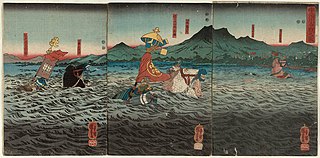
Minamoto no Yoshinaka tried to wrest power from his cousins Yoritomo and Yoshitsune, seeking to take command of the Minamoto clan. To that end, he burned the Hōjūji Palace, and kidnapped Emperor Go-Shirakawa. However, his cousins Noriyori and Yoshitsune caught up with him soon afterwards, following him across the Bridge over the Uji, New Year's Day, 1184, which Yoshinaka had torn up to impair their crossing.

Minamoto no Yoshinaka made his final stand at Awazu, after fleeing from his cousins' armies, which confronted him after he attacked Kyoto, burning the Hōjūjiden, and kidnapping Emperor Go-Shirakawa. During the pursuit, he was joined by his foster brother Imai Kanehira and Tomoe Gozen.
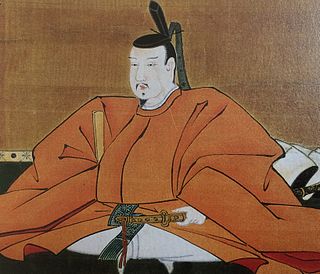
Minamoto no Noriyori was a Japanese samurai lord of the late Heian period and early Kamakura period, who fought alongside his brothers Minamoto no Yoritomo and Minamoto no Yoshitsune at a number of battles of the Genpei War. He was the sixth son of Minamoto no Yoshitomo.

Tomoe Gozen was an onna-musha, a female samurai, mentioned in The Tale of the Heike. There is doubt as to whether she existed as she doesn't appear in any primary accounts of the Genpei war. She only appears in the epic "The tale of the Heike". She served under samurai lord Minamoto no Yoshinaka during the Battle of Awazu, part of the Genpei War in the late Heian period, which led to the establishment of the Kamakura shogunate.

Minamoto no Yukiie was a brother of Minamoto no Yoshitomo, and one of the commanders of the Minamoto forces in the Genpei War at the end of the Heian period of Japanese history.

Taira no Munemori was heir to Taira no Kiyomori, and one of the Taira clan's chief commanders in the Genpei War.

Kajiwara Kagetoki was a samurai and retainer of the Kamakura Shogunate during the late Heian and early Kamakura period. He was a spy for Minamoto no Yoritomo in the Genpei War, and a warrior against the Taira clan. He came to be known for his greed and treachery. He was a prominent eastern warrior and supplied Minamoto no Yoshitsune with a number of ships after the Battle of Yashima.
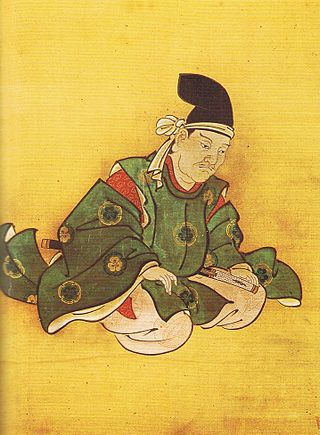
Imai Kanehira was a military commander of the late Heian Period of Japan. He was the son of Nakahara Kaneto and brother of Higuchi Kanemitsu.

Moon Saga: Mysteries of Yoshitsune I & II is a duology of theatre stage plays written, composed and directed by Japanese recording artist Gackt. The original productions are notable for the first major use of projection mapping in theatre stage plays. The original soundtrack was released on October 1, 2014 and compiles music from the plays. It consists of two music CDs, one for each chapter, the first of which was performed in 2012, while the second was performed in 2014.


















